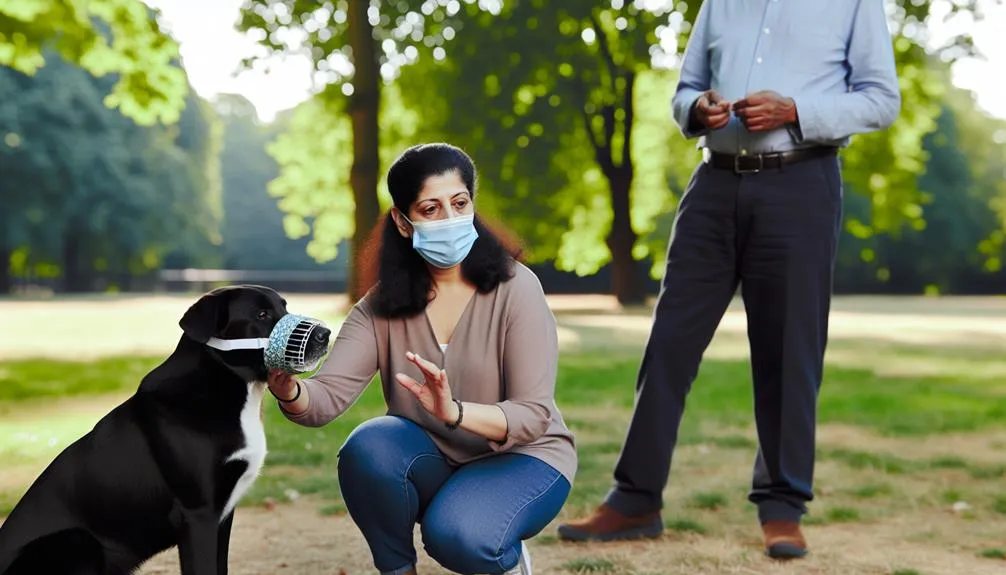
How to Muzzle a Dog With No Muzzle
When you find yourself in a situation where a dog needs to be muzzled but you don't have a traditional muzzle on hand, it's important to know how to improvise effectively. You might be surprised at how everyday items can serve this purpose, but the key is to guarantee the dog's comfort and safety while preventing potential bites. Understanding the right techniques can make all the difference in a stressful moment. So, what are the best alternatives, and how can you ensure your dog remains calm throughout the process?
Understanding the Need for Muzzling
Understanding the need for muzzling a dog can be challenging, especially if you're unfamiliar with the various situations that may warrant it. Muzzling isn't just about restricting a dog's ability to bite; it's a tool for managing dog behavior and addressing safety concerns for both your pet and those around them.
Certain scenarios may arise where a muzzle can play an important role. For example, if your dog has exhibited fear or aggression in unfamiliar situations, a muzzle can help prevent potential incidents. This doesn't mean your dog is inherently dangerous; rather, it's a precaution to guarantee everyone's safety. Additionally, during visits to the vet or groomer, a muzzle can reduce stress for both the dog and the handler, as it prevents sudden movements that could lead to bites when your dog feels threatened.
It's also important to recognize that muzzling isn't a solution for behavioral issues. Instead, it should be part of a broader training plan. Understanding your dog's triggers and working on desensitization techniques can help address underlying problems.
Using a muzzle can create a safer environment but should be done thoughtfully. When you decide to muzzle your dog, always consider the context and be aware of their comfort level. A well-fitted muzzle can allow your dog to breathe, drink, and even bark while still providing the necessary safety measures. By being proactive and informed, you're taking vital steps toward responsible dog ownership.
Temporary Muzzle Alternatives
What if you find yourself in a situation where a traditional muzzle isn't available? It can be stressful, but there are temporary muzzle alternatives you can use to keep both your dog and others safe. One effective method is the bandage technique. This approach uses materials you likely have around the house, such as strips of fabric or even an old t-shirt.
When selecting fabric options, make sure they're sturdy yet soft enough to avoid causing discomfort to your pet. Avoid using materials that could snag or irritate their skin. Cut a strip of fabric about three to four inches wide and long enough to wrap around your dog's snout, leaving enough length to secure it comfortably behind their ears.
To create a makeshift muzzle, gently wrap the fabric around your dog's snout, making certain it's snug but not too tight. You should be able to fit a couple of fingers between the fabric and your dog's snout for comfort. Tie the ends behind their ears, making sure it's secure but not restrictive. This temporary solution can help prevent your dog from biting or barking when they're feeling anxious or in an unfamiliar environment.
Step-by-Step Muzzling Techniques

If you find yourself needing to use a muzzle for your dog, it's important to know the right techniques to guarantee it's done safely and effectively. Understanding your dog's behavior is vital in these situations, as it helps you maintain control while making certain of their comfort. Here's a step-by-step guide to help you through the process.
Step-by-Step Muzzling Techniques
| Step | Action | Notes |
|---|---|---|
| 1 | Assess the situation | Determine if muzzling is necessary. Make certain it's a safe environment. |
| 2 | Gather your materials | Use a soft cloth or a bandana as a temporary muzzle. |
| 3 | Approach calmly | Speak softly to your dog to reduce anxiety. |
| 4 | Create the muzzle | Fold the cloth and wrap it around the dog's snout, leaving space for breathing. |
| 5 | Secure the muzzle | Tie the ends behind the dog's head, making sure it's snug but not too tight. |
Tips for Dog Comfort
To guarantee your dog feels comfortable while wearing a muzzle, it's essential to create a positive experience around the process. Start by introducing the idea of a muzzle gradually. Let your dog explore the muzzle, sniff it, and even reward them with treats to build a positive association. This is particularly important if your dog experiences anxiety; making the muzzle a non-threatening object can greatly reduce their stress.
Consider using comfort measures like gentle handling and a calm voice. Speak softly to reassure your dog throughout the process. If they seem nervous, take a step back and give them time to adjust. You might also try desensitizing them to the feel of the muzzle by placing it on their face for just a few seconds initially, gradually increasing the duration as they become more comfortable.
Another effective approach is to use distractions. Engage your dog with their favorite toy or a tasty treat while you're introducing the muzzle. This can help shift their focus away from any anxiety they might feel. Keep your training sessions short and positive; ending on a good note is key.
When to Seek Professional Help

Sometimes, despite your best efforts, a dog may still struggle with the muzzle process, showing signs of extreme anxiety or aggression. If you notice that your dog is becoming increasingly distressed or unmanageable during training, it's crucial to step back and evaluate the situation. Recognizing when to seek professional help can make a significant difference in your dog's comfort and safety.
Consider reaching out for a behavior assessment if you find yourself in any of the following situations:
| Signs of Distress | Possible Causes | Recommended Action |
|---|---|---|
| Excessive barking or growling | Fear and anxiety | Consult a behaviorist |
| Attempts to bite or snap | Aggression or frustration | Seek a professional trainer |
| Withdrawal or hiding | Overwhelmed by the process | Consider a gentle approach |
| Inability to progress | Lack of effective techniques | Engage a training expert |
Professional trainers can provide tailored training techniques that address your dog's specific needs. They can assist in creating a safe, structured environment for your dog to learn in a positive manner. Remember, seeking help isn't a sign of failure; it's a proactive step toward a happier, more balanced relationship with your furry friend. By working with experts, you'll not only enhance your dog's comfort but also empower yourself with effective strategies moving forward.
Frequently Asked Questions
Can I Use Household Items as a Muzzle Alternative?
Yes, you can use household alternatives for DIY muzzling. Items like a soft cloth or an old T-shirt can help, but make sure it's comfortable and secure. Always monitor your dog's behavior when using them.
How Can I Calm My Dog Before Muzzling?
To calm your dog before muzzling, use positive reinforcement. Try soothing voice tones, gentle petting, or treats. Implement calming techniques like deep breathing or a quiet space to help your dog feel secure and relaxed.
Are There Specific Breeds That Require Muzzles More Often?
Did you know that 20% of dog owners report needing a muzzle due to specific breed characteristics? Muzzle training is essential for certain breeds, especially those known for aggression or high energy, ensuring safety for all.
What Signs Indicate My Dog Is Uncomfortable With a Muzzle?
When your dog's uncomfortable with a muzzle, watch for body language cues like stiff posture or lowered head. Stress signals, such as excessive panting or attempting to paw at the muzzle, indicate they need a break.
How Long Can I Safely Keep a Muzzle on My Dog?
When considering muzzle duration, it's essential to prioritize your dog's comfort. Generally, keep it on for short periods, ensuring breaks for hydration and relief. Always observe their behavior to maintain safe practices for their well-being.
Conclusion
In moments when your dog feels like a wild, untamed beast, a temporary muzzle can transform them into a calm, gentle companion. By using a simple fabric, you're not just preventing bites; you're creating a safety net for both you and your furry friend. Remember, the goal is to keep everyone safe and comfortable. If your pup's anxiety spirals into chaos, don't hesitate to seek professional help—because every dog deserves a peaceful moment, even amidst the storm.
You may also like
Archives
Calendar
| M | T | W | T | F | S | S |
|---|---|---|---|---|---|---|
| 1 | 2 | 3 | 4 | 5 | 6 | |
| 7 | 8 | 9 | 10 | 11 | 12 | 13 |
| 14 | 15 | 16 | 17 | 18 | 19 | 20 |
| 21 | 22 | 23 | 24 | 25 | 26 | 27 |
| 28 | 29 | 30 | ||||
Leave a Reply